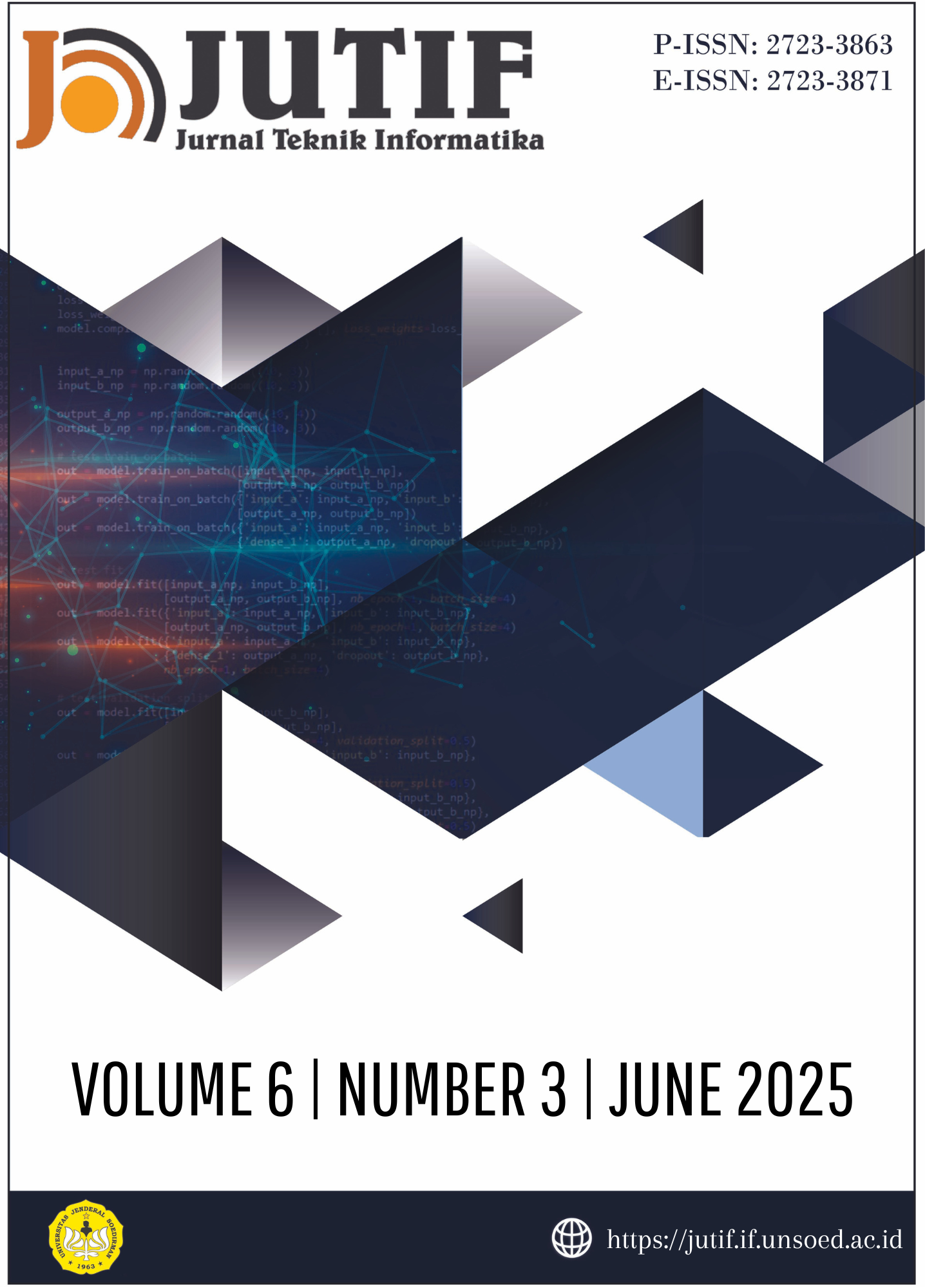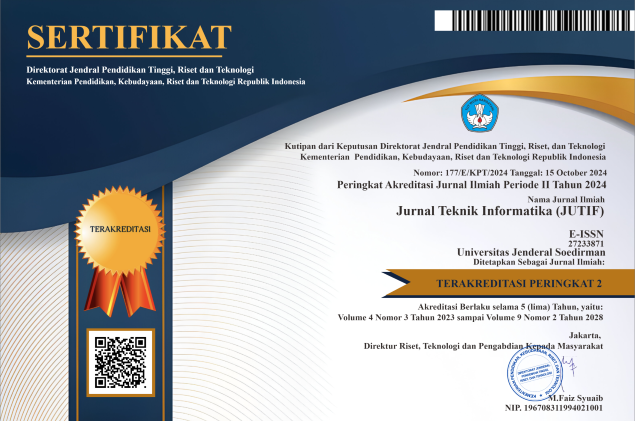Enhancing The Precision Detection and Grading of Diabetic Retinopathy through Digital Retinal Imaging Using 3D Convolutional Neural Networks
DOI:
https://doi.org/10.52436/1.jutif.2025.6.3.4387Keywords:
3D Convolutional Neural Networks (3D-CNNs), Binary Classification, Data Augmentation, Deep Learning, Diabetic Retinopathy (DR), Diagnostic Precision, Multiclass Classification, OphthalmologyAbstract
Diabetic retinopathy (DR) is a pressing global health issue that affects the retina and is closely linked to diabetes, leading to vision impairment and blindness, particularly in adults. With the rising incidence of diabetes, the need for efficient and accurate DR screening is critical for early intervention and improved patient outcomes. Automated screening solutions can streamline this process, allowing healthcare professionals to focus more on patient care.In this study, we harnessed advanced deep learning techniques, specifically 3D convolutional neural networks (3D-CNNs), to classify DR into binary categories (presence or absence) and five multiclass categories: mild, moderate, no DR, proliferative DR, and severe DR. Our goal was to enhance diagnostic Precision in ophthalmology. To optimize our models, We embraced two methods transformative data augmentation: random shifting and random weak Gaussian blurring, empowering our model to reach new heights,as well as their combination. Our results showed that, for binary classification, the combined augmentation achieved significant success, The multiclass model was trained without any data augmentation excelled in Precision. These findings highlight the importance of large, high-quality research datas in deep learning algorithms. By leveraging advanced methodologies and robust data, we can transform diabetic retinopathy screening, promoting earlier detection and better treatment outcomes for those affected.
Downloads
References
X. Lin, Y. Xu, and X. Pan, “Global, regional, and national burden and trend of diabetes in 195 countries and territories: An analysis from 1990 to 2025,” Sci. Rep., vol. 10, no. 1, pp. 1–11, 2020.
G. Kalyani, B. Janakiramaiah, A. Karuna, and L. V. N. Prasad, “Diabetic retinopathy detection and classification using capsule networks,” Complex Intell. Syst., 2021.
E. Decencière, G. Cazuguel, and X. Zhang, “TeleOphta: Machine learning and image processing methods for tele-ophthalmology,” IRBM, vol. 34, no. 2, pp. 196–203, 2013.
H. Riaz, J. Park, H. Choi, H. Kim, and J. Kim, “Deep and densely connected networks for classification of diabetic retinopathy,” Diagnostics, vol. 10, no. 1, p. 24, 2020.
A. Samanta, A. Saha, S. C. Satapathy, S. L. Fernandes, and Y. D. Zhang, “Automated detection of diabetic retinopathy using convolutional neural networks on a small research data,” Pattern Recognit. Lett., vol. 135, pp. 293–298, 2020.
S. R. Shiva, R. R. N. Sethi, and M. Gadiraju, “Extensive analysis of machine learning algorithms for early detection of diabetic retinopathy,” Mater. Today: Proc., 2020.
G. Saxena, D. K. Verma, A. Paraye, A. Rajan, and A. Rawat, “Improved and robust deep learning agent for preliminary detection of diabetic retinopathy using public research data,” Intell.-Based Med., vol. 3–4, 2020, [Online]. Available: https://doi.org/10.1016/j.ibmed.2020.100022 (DOI inferred from “Art. no. 100022” and common practice for journal articles)
M. M. Butt, G. Latif, D. N. F. A. Iskandar, J. Alghazo, and A. H. Khan, “Multi-channel convolutional neural network based diabetic retinopathy detection from ophthalmoscopic images,” in Procedia Computer Science, 2019, pp. 283–291.
M. M. Islam, H.-C. Yang, T. N. Poly, W.-S. Jian, and Y. C. Li, “Deep learning algorithms for detection of diabetic retinopathy in retinal fundus photographs: a systematic review and meta-analysis,” Comput Methods Programs Biomed, vol. 191, p. 105320, 2020.
H. Safi, S. Sfi, A. Hafezi-Moghadam, and H. Ahmadieh, “Early detection of diabetic retinopathy,” Surv Ophthalmol, vol. 63, no. 5, pp. 601–608, 2018.
A. P. Bhatkar and G. U. Kharat, “Detection of diabetic retinopathy in ophthalmoscopic images using MLP classifier,” in 2015 IEEE International Symposium on Nanoelectronic and Information Systems, 2015, pp. 331–335.
T. Shanthi and R. S. Sabeenian, “Modified AlexNet architecture for classification of diabetic retinopathy images,” Computers & Electrical Engineering, vol. 76, pp. 56–64, 2019.
S. Wan, Y. Liang, and Y. Zhang, “Deep convolutional neural networks for diabetic retinopathy detection by image classification,” Computers & Electrical Engineering, vol. 72, pp. 274–282, 2018.
G. T. Zago, R. V Andréão, B. Dorizzi, and E. O. T. Salles, “Diabetic retinopathy detection using red lesion localization and convolutional neural networks,” Comput Biol Med, vol. 116, p. 103537, 2020.
V. Gulshan, L. Peng, and M. Coram, “Development and validation of a deep learning algorithm for detection of diabetic retinopathy in retinal fundus photographs,” JAMA, vol. 316, no. 22, pp. 2402–2410, 2016.
J. Y. Choi, T. K. Yoo, J. G. Seo, J. Kwak, T. T. Um, and T. H. Rim, “Multi-categorical deep learning neural network to classify ophthalmoscopic images: a pilot study employing small database,” PLoS One, vol. 12, no. 11, 2017, [Online]. Available: https://doi.org/10.1371/journal.pone.0187336 (DOI inferred from “article e0187336” and common practice for journal articles)
R. Sayres, A. Taly, and E. Rahimy, “Using a deep learning algorithm and integrated gradients explanation to assist grading for diabetic retinopathy,” Ophthalmology, vol. 126, no. 4, pp. 552–564, 2019.
S. M. S. Islam, M. M. Hasan, and S. Abdullah, “Deep learning based early detection and grading of diabetic retinopathy using retinal ophthalmoscopic images,” 2018.
K. Shankar, A. R. W. Sait, D. Gupta, S. K. Lakshmanaprabu, A. Khanna, and H. M. Pandey, “Automated detection and classification of fundus diabetic retinopathy images using synergic deep learning model,” Pattern Recognit Lett, vol. 133, pp. 210–216, 2020.
E. Beede, E. Baylor, and F. Hersch, “A human-centered evaluation of a deep learning system deployed in clinics for the detection of diabetic retinopathy,” in Proceedings of the 2020 CHI Conference on Human Factors in Computing Systems, 2020, pp. 1–12.
O. Vinyals, C. Blundell, T. Lillicrap, K. Kavukcuoglu, and D. Wierstra, “Matching networks for one shot learning,” in Advances in Neural Information Processing Systems, 2016, pp. 3630–3638.
J. Snell, K. Swersky, and R. Zemel, “Prototypical networks for few-shot learning,” in Advances in Neural Information Processing Systems, 2017, pp. 4077–4087.
F. Sung, Y. Yang, L. Zhang, T. Xiang, P. H. S. Torr, and T. M. Hospedales, “Learning to compare: relation network for few-shot learning,” in 2018 IEEE/CVF Conference on Computer Vision and Pattern Recognition, 2018, pp. 1199–1208.
J. Xia, D. Deng, and D. Fan, “A note on implementation methodologies of deep learning-based signal detection for conventional MIMO transmitters,” IEEE Transactions on Broadcasting, vol. 66, no. 3, pp. 744–745, 2020.
K. He, Z. Wang, D. Li, F. Zhu, and L. Fan, “Ultra-reliable MU-MIMO detector based on deep learning for 5G/B5G-enabled IoT,” Physical Communication, vol. 43, pp. 101181–101187, 2020.
B. K. Yousafzai, S. Afzal, and T. Rahman, “Student-performulator: student academic performance using hybrid deep neural network,” Sustainability, vol. 13, no. 17, p. 9775, 2021.
W. U. Khan, M. A. Javed, T. N. Nguyen, S. Khan, and B. M. Elhalawany, “Energy-efficient resource allocation for 6G backscatter-enabled NOMA IoV networks,” IEEE Transactions on Intelligent Transportation Systems, 2021.
C. Li, J. Xia, and F. Liu, “Dynamic offloading for multiuser Multi-CAP MEC networks: a deep reinforcement learning approach,” IEEE Trans Veh Technol, vol. 70, no. 3, pp. 2922–2927, 2021.
W. U. Khan, F. Jameel, X. Li, M. Bilal, and T. A. Tsiftsis, “Joint spectrum and energy optimization of NOMA-enabled small-cell networks with QoS guarantee,” IEEE Trans Veh Technol, vol. 70, no. 8, pp. 8337–8342, 2021.
Y. Guo, Z. Zhao, K. He, S. Lai, J. Xia, and L. Fan, “Efficient and flexible management for industrial Internet of Things: a federated learning approach,” Computer Networks, vol. 192, pp. 108122–108129, 2021.
W. U. Khan, X. Li, A. Ihsan, M. A. Khan, V. G. Menon, and M. Ahmed, “NOMA-enabled optimization framework for next-generation small-cell IoV networks under imperfect SIC decoding,” IEEE Transactions on Intelligent Transportation Systems, 2021.
X. Li, Y. Zheng, and W. U. Khan, “Physical layer security of cognitive ambient backscatter communications for green Internet-of-Things,” IEEE Transactions on Green Communications and Networking, vol. 5, no. 3, pp. 1066–1076, 2021.
W. U. Khan, X. Li, M. Zeng, and O. A. Dobre, “Backscatter-enabled NOMA for future 6G systems: a new optimization framework under imperfect SIC,” IEEE Communications Letters, vol. 25, no. 5, pp. 1669–1672, 2021.
F. Jameel, W. U. Khan, N. Kumar, and R. Jantti, “Efficient power-splitting and resource allocation for cellular V2X communications,” IEEE Transactions on Intelligent Transportation Systems, vol. 22, no. 6, pp. 3547–3556, 2021.
W. U. Khan, F. Jameel, N. Kumar, R. Jantti, and M. Guizani, “Backscatter-enabled efficient V2X communication with non-orthogonal multiple access,” IEEE Trans Veh Technol, vol. 70, no. 2, pp. 1724–1735, 2021.
A. U. Khan, M. Tanveer, and W. U. Khan, “An enhanced spectrum reservation framework for heterogeneous user in CR-enabled IoT networks,” IEEE Wireless Communications Letters, vol. 10, p. 1, 2021.
A. B. Tufail, Y.-K. Ma, and M. K. A. Kaabar, “Deep learning in cancer diagnosis and prognosis prediction: a mini-review on challenges, recent trends, and future directions,” Comput Math Methods Med, vol. 2021, 2021, [Online]. Available: https://doi.org/10.1155/2021/9025470 (DOI inferred from “Article ID 9025470” and common practice for journal articles)
A. B. Tufail, Y.-K. Ma, and Q.-N. Zhang, “3D convolutional neural networks-based multiclass classification of Alzheimer’s and Parkinson’s diseases using PET and SPECT neuroimaging modalities,” Brain Inform, vol. 8, no. 1, p. 23, 2021.
S. Ji, W. Xu, M. Yang, and K. Yu, “3D convolutional neural networks for human action recognition,” IEEE Trans Pattern Anal Mach Intell, vol. 35, no. 1, pp. 221–231, 2013.
S. Tang, W. Zhou, L. Chen, L. Lai, J. Xia, and L. Fan, “Battery-constrained federated edge learning in UAV-enabled IoT for B5G/6G networks,” Physical Communication, vol. 47, pp. 101381–101389, 2021.
J. Xia, L. Fan, and W. Xu, “Secure cache-aided multi-relay networks in the presence of multiple eavesdroppers,” IEEE Transactions on Communications, vol. 67, no. 11, pp. 7672–7685, 2019.
V. Nair and G. E. Hinton, “Rectified linear units improve restricted Boltzmann machines,” in ICML, 2010, pp. 807–814.
R. Khan, Q. Yang, and I. Ullah, “3D convolutional neural networks based automatic modulation classification in the presence of channel noise,” IET Communications, 2021.
A. Azulay and Y. Weiss, “Why do deep convolutional networks generalize so poorly to small image transformations?,” Journal of Machine Learning Research, vol. 20, pp. 1–25, 2019.
Additional Files
Published
How to Cite
Issue
Section
License
Copyright (c) 2025 Autho Allwine, Mutiara S Simanjuntak, Wahyu Aji Pulungan

This work is licensed under a Creative Commons Attribution 4.0 International License.



























